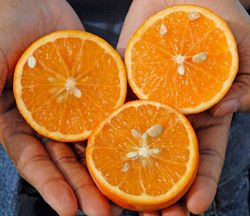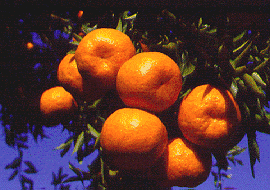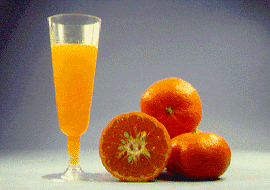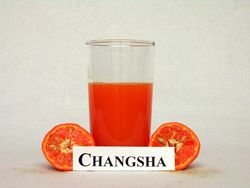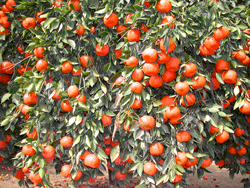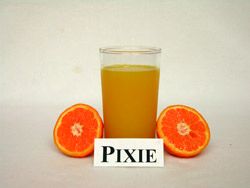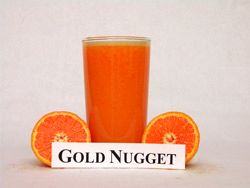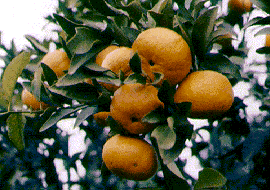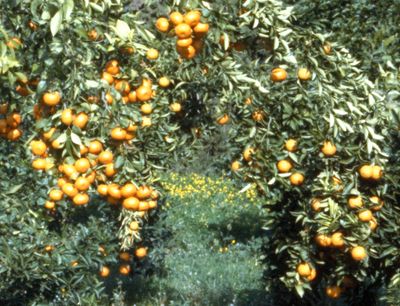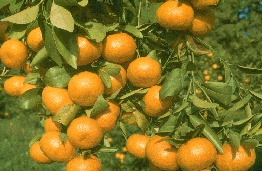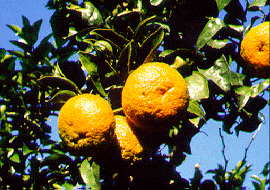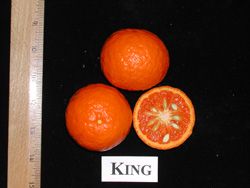|
|||||||||
Select any of 50 available languages! |
|||||||||
Mandarins |
||
| Citrus reticulata |
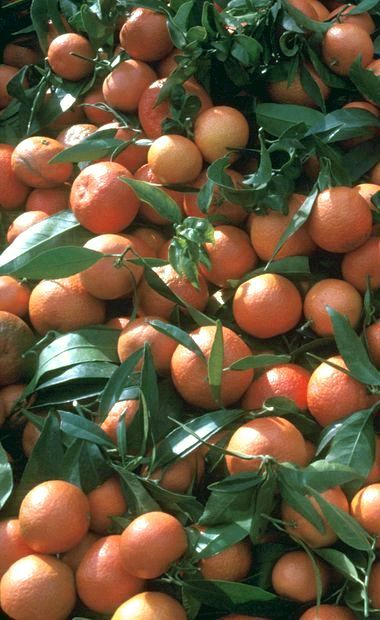 |
History and distribution today The group of Mandarins Classification Cultivation Uses Mandarin types (Index to mandarin varieties) Mandarin Citrus reticulata Satsumas Citrus unshiu Mediterranean (Willowleaf) mandarin Citrus deliciosa Tangors Tangelos Tangelo × Clementine hybrids King × Willowleaf hybrids Tangerine × Willowleaf × Tangor hybrids |
|
Clementines © Gérard Paillard / INRA |
Classification
|
|||||||||||||||
| Mandarin Citrus reticulata |
| Common
mandarin |
| Back to mandarin types | Back to beginning | |
| Clementines |
| LAT | Citrus reticulata Blanco |     |
| Syn | Citrus clementina
Tanaka Citrus reticulata var. chrysocarpa Tanaka Citrus deliciosa x Citrus sinensis |
|
Clementines were earlier thought to be hybrids of the Mediterranean mandarin and sour orange, but in 2002 scientists working in Corsica at the French National Institute of Agricultural Research (INRA) found by studying its chromosomes that the clementine is a hybrid of the Mediterranean mandarin as the seed parent and a sweet orange as the pollen parent. This highly important North African variety originated in 1902 as an accidental hybrid in a planting of mandarin seedlings (not grafted) of the Mediterranean mandarin, made by Father Clement Rodier in the garden of the orphanage of the Pères du Saint-Esprit at Misserghin, a small village near Oran, Algeria. The full story and the origin of the clementine are in an INRA press release. Fruit size is variable, ranging from medium-small to medium. Form likewise quite variable, with a range from slightly oblate through globose to oblong and sometimes broadly pyriform from development of neck or collar. Rind medium in thickness, moderately firm and adherent but easily peelable and does not puff until well after maturity. Surface smooth and glossy but slightly pebbled because of prominent oil glands; colour deep orange to reddish-orange. Flesh deep orange; tender and melting; juicy; flavour sweet; subacid and aromatic. Seedless to very few seeds (depending on possible cross-pollination). Matures early. In addition to the varieties presented below, other well-known clementine cultivars include: Bruno, Esbal, Fina Sodea, Orogrande and Ragheb. |
||
| ENG | Clementine, Loose rind mandarin, Mandarin orange | |
| FRA | Clémentine | |
| I TA | Clementina, Mandarancia | |
| ESP | Clementina | |
| Photos | (1,4) © Gérard Paillard / INRA (2) © C. Jacquemond / INRA (3) © UC-Riverside CCPP |
|
| European autumn favourites | ||
| LAT | Citrus reticulata Blanco | 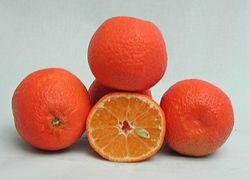    |
Citrus reticulata ‘Marisol’ Citrus reticulata 'Clemenules' Citrus reticulata 'Oroval' |
||
Marisol (top picture) A vigorous variety of citrus tree, but thorny in the early years. The fruit is larger than Clemenules (see below), but the tree has a tendency to drop its fruit after heavy rain. It is therefore picked early and degreened if needed. The flesh is tender and juicy. Many like its characteristic sprightly flavour. The appearance of Marisol clementine in the shops is often taken as a first sign of autumn. Matures in October - November Clemenules (Nules, Clementina de Nules) originated as a budsport of Monreal in the town of Nules in the Castellon province, Spain. Clemenules is considered one of the best clementines for sweetness and flavour. The tree is vigorous but is ideal for limited space because it can be kept as a small bush and still bear abundant fruit. The seedless and juicy fruits mature in November. Oroval (bottom picture) A spontaneous mutation of Fina, discovered in 1950. Oroval fruit are slightly larger but have less exterior colouration than other clementines. |
||
| ENG | Clementines Marisol, Clemenules and Oroval | |
| FRA | Clémentines Marisol, Clemenules et Oroval | |
| Photos | (1) © UCR CCPP (2-3) © Gene Lester (4) © Joe Real |
|
| North African stars | ||
| LAT | Citrus reticulata Blanco |  Algerian   Nour 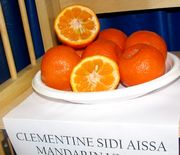 Sidi Aissa   Monreal  Carte Noir |
Citrus reticulata 'Algerian' Citrus reticulata 'Nour' Citrus reticulata 'Sidi Aissa' Citrus reticulata 'Monreal' Citrus reticulata 'Carte noir' |
||
Algerian also known as Commune. Commune and Monreal were the two original Clementine clones in Algeria. Tree is medium in vigor and size, spreading and round-topped; branchlets fine-stemmed, willowy, and nearly thornless; foliage dense. Leaves highly variable in size, narrowly lanceolate in form, and somewhat resembling the Mediterranean or Willowleaf mandarin. In most locations, regular and satisfactory bearing is assured only by the provision of cross-pollination. Tree strongly cold-resistant. Nour. This variety is an important Moroccan clementine. The fruit is of good colour but the rind texture is often coarse. The flesh is tender, juicy and of very good flavour. Harvest is mid to late January. The fruit will stay on the tree in good condition until March. Sidi Aissa. A mutation of Fina clementine discovered in Morocco. Valued there because of its large fruit size and durable peel. Sidi Aissa is very productive. It is said to have the same maturity period as Clemenules but better internal colour and flavour. Monreal was found in 1940 in the orchard of Vincent Monreal at Perregaux, Oran. It is one of the most important mandarin varieties in the Mediterranean basin because of its early ripening in October. Monreal is self-compatible and without cross-pollination the fruit is regularly seedy. Monreal Clementine is one of the sweetest and easiest to peel in the mandarin family. Carte noir is a Moroccan variety also known as 'Bekria'. It is a low-acidity early clementine variety. The pulp is fairly juicy, seedless, soft-textured and a pale orange colour. It is much appreciated locally by the North African community in France. Carte noir is one of the earliest citrus fruits to mature in the Mediterranean region. It is available from mid-September to mid-October. |
||
| ENG | Clementines Algerian, Nour, Sidi Aissa, Monreal and Carte Noir | |
| FRA |
Clémentines Commune, Nour, Sidi Aissa, Monreal et Carte Noir | |
| Photos | (1) © C. Jacquemond
/ INRA
(2-3,5-6) © Gene Lester (4) © Joe Real © UCR Citrus Variety Collection |
|
| Clementine hybrids |
| Two of the most common clementine hybrids are: Nova (Clemenvilla), often sold
as a tangelo,
and
Ortanique, often sold as a tangor. Both have many synonym names. Both are premium flavour mandarins for marmalade and jams. Other important clementine hybrids described on the Mandarin hybrids page include: |
| Back to mandarin types | Back to beginning | |
| Tangerines |
| LAT | Citrus reticulata Blanco | 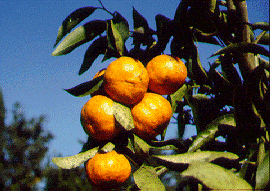 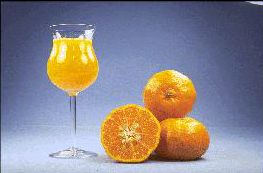 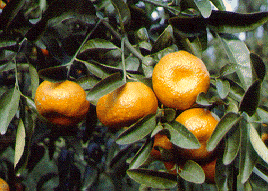 |
| Syn | Citrus tangerina Tanaka | |
Some confusion exists as to the proper use of the word tangerine. Tangerines were originally a group of Moroccan mandarin varieties (and their later hybrids) exported through the port of Tangier (Tanger in French), a town at the northern tip of Morocco, opposite Gibraltar. Some of the early mandarin varieties introduced to the United States came from Morocco. These varieties had skins of strong bright red colour. Horticulturists have tried to limit the use of the name tangerine to cultivars of similar deep colour. However, the name tangerine is commonly used in North America to denote all mandarin types. In this presentation only 'Dancy' and 'Beauty' are described as tangerines. More recently the name tangerine has been used of the other parent of mandarin × orange and mandarin × grapefruit hybrids in order to secure the names tangor and tangelo. As Dancy was one of the first varieties used in these hybrids the names seemed justified. In the Mediterranean region the name mandor has recently been introduced to describe mandarin × orange hybrids. All said, within the group of mandarins the tangerines do not form a subgroup of natural significance. The use of the name tangerine is a matter of convenience. Among other varieties Tanaka included in his Citrus tangerina species are: Redskin (Du Cap), Sanguigno (Trabut) which is a blood tangerine, Swatow (Vermillion) and the south-east Asian cultivars Da hong pao (Juhong) and Suen (Suen Kat). |
||
| ENG | Tangerine | |
| FRA | Tangerine | |
| GER | Tangerine | |
| Photos | © C. Jacquemond / INRA | |
| Back to mandarin types | Back to beginning | |
| Satsumas Citrus reticulata |
| Early ripening Wase satsumas | ||
| LAT | Citrus reticulata Blanco |   Miyagawa   Okitsu  Seto  Miho  Kuno |
|
Citrus reticulata 'Miyagawa' Citrus reticulata ’Okitsu’ Citrus reticulata 'Miho' Citrus reticulata 'Seto' Citrus reticulata ’Kuno' |
||
Since the satsumas are characterized by early fruit maturity, the Wase varieties are very early ripening — late September and October. As a group the trees are said to be more or less lacking in vigor, slow growing, and dwarfed. They have moderately dense foliage consisting of relatively small leaves with slender, fairly line-marginated petioles 'Miyagawa' Fruit large (for satsuma), moderately oblate, seedless with thin and smooth rind. Juice abundant, sugars and acid well-blended, and quality excellent. Matures very early and stores well for Wase Unshû. Is reported to reach legal maturity by the second week of September in optimal conditions. Tree more vigorous than most old Wase clones and productive. Miyagawa originated as a limb sport in a Zairai tree in Fukuoka Prefecture and was named and introduced by Dr. Tyôzaburô Tanaka in 1923. It is currently the best known and much the most extensively grown of the Wase varieties. 'Okitsu' Fruit somewhat more oblate than Miyagawa; averages higher in sugar content but matures a few weeks later. The tree is also more vigorous. Okitsu originated as a nucellar seedling of Miyagawa from a controlled pollination with Poncirus trifoliata made by Doctors M. Kajiura and T. Iwasaki at the Horticultural Research Station, Okitsu, in 1940. It was distributed for trial in 1953, registered in 1963. It was introduced to Europe in 1983 and is slowly replacing Miyagawa as the most popular very early variety, especially outside Japan. It was soon followed by sister varieties Miho and Seto. Seto and Miho are early-maturing, high-quality, cold-tolerant varieties obtained from Japan and developed from seed produced by controlled pollination of Miyagawa satsuma, similar to Okitsu above. The original trees were grown from seed planted in 1984 and they first fruited in 1990. Mature leaves are 12-16 cm long and 5-6 cm wide, with almost non-existent petiole wings, with Seto leaves being the larger. Trees are medium is size (3.0 - 3.7 m) with a low, spreading habit (4.0-4.6 m). 'Seto' Seto branches tend to droop compared to Miho.Seto leaves are oblong as opposed to elliptic for Miho. Seto peel is clearly smoother and thinner than other Satsumas. The fruit is noticeably flat and packs easily. Average full size is 10 x 3 cm usually containing 11 segments. Seto season is October through November. 'Miho' Miho tends to have more upright branching. Leaves are elliptic as opposed to oblong for Seto. Miho peel is smooth, thin, leathery and easy to peel. Average fruit size is 9 x 4 cm, usually with 10 segments. Miho season is October through November 'Kuno' is also known as Kuno Wase, Wasi and Temprana. Other well-known very early Wase satsuma varieties include: Matsuyama, Obawase and Iseki. |
||
| ENG | Miyagawa, Okitsu, Seto, Miho and Kuno satsumas | |
| FRA | Miyagawa, Okitsu, Seto, Miho et Kuno variétés de mandarine satsuma. | |
| Photos | (1) © Gene Lester (2) © UCR Citrus Variety Collection (3,7) © CCPP (4-6) © Aggie Horticulture TAMU |
|
| Link | Aggie Horticulture TAMU | |
| Late ripening Unshû satsumas | ||
| LAT | Citrus reticulata Blanco |  Owari  Silverhill  Dobashi Beni  Kimbrough 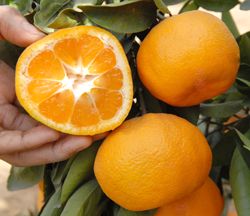 Aoshima |
| Syn |
Citrus reticulata ’Owari’ Citrus reticulata 'Silverhill' Citrus reticulata 'Dobashi Beni' Citrus reticulata 'Kimbrough' Citrus reticulata 'Aoshima' |
|
|
The late satsuma varieties ripen in November-December and hence are early to medium-early mandarins in their maturity season. 'Owari' Owari is perhaps the most widely grown satsuma variety in the world today. This variety is of ancient and unknown Japanese origin presumably from the old province of Owari. Fruit medium in size, medium-oblate to subglobose, seedless. Orange-coloured but commonly matures in advance of good colouration. Rind thin and leathery, surface smooth to slightly rough, easily separable. Segments 10 to 12, loosely separable, axis hollow. Flesh orange-coloured, tender and melting, flavour rich but subacid. Season of maturity early November-December. Fruit holds poorly on trees after maturity and must be picked promptly but stores well. Tree moderately vigorous but slow-growing, medium-small, spreading and drooping, very productive. 'Silverhill' Fruit medium in size, slightly more oblate than most, rind relatively thin and smooth, seedless. Juice abundant; sugars high and acid low (hence very sweet); quality excellent, stores well. Season of maturity early (November). Tree very vigorous (for satsuma), more upright than most others, productive, markedly cold-resistant. 'Dobashi Beni' Distinctive because of its deep orange-red colour. Fruit of good quality, ripening in late November or early December. Tree of medium vigour. This variety originated as a limb sport of Owari in the orchard of K. Dobashi in Shizuoka Prefecture and was noted about 1940. 'Kimbrough' Kimbrough is a Louisiana Agriculture Experiment Station release. Its cold-hardiness is about the same as 'Owari'. Kimbrough trees are large, strong, spreading and very productive. The fruit is generally larger than Owari and stores well on the tree after maturity. Kimbrough fruit is noted for its large size and the fact it has fewer seeds than other varieties of Satsuma. Excellent flavor. Kimbrough is reported to be hardy down to 12F ( -11 C) and it is known to have survided single digit temperatures for a few hours. Season is November-December. 'Aoshima' Aoshima is an Owari mutant discovered by H. Aoshima in 1950 in Fukudaga Valley, Shizuoka Prefecture. It is one of the leading late-maturing varieties of satsuma; harvested from mid-December to early January. Aoshima trees are vigorous, densely foliated and precocious as well as being reliable bearers. The fruit is larger than most other satsuma mandarin cultivars and has an attractive oblate shape with a smooth textured rind. Other well-known late satsuma varieties include: Hayashi, Ishikawa, and Sugyiama.
|
||
| ENG | Owari, Silverhill, Dobashi Beni, Kimbrough and Aoshima satsumas | |
| FRA | ||
| Photos | (1,3) © UC-Riverside CCPP
(2) © Joe Real (4) © Aggie Horticulture TAMU (5) © UCR Citrus Variety Collection |
|
| Link | ||
| Newer Satsuma varieties | ||
| LAT | Citrus reticulata Blanco |
 Dart South  Xie Shan |
| Syn | Citrus reticulata 'Armstrong' Citrus reticulata ’Dart North Owari’ Citrus reticulata ‘Dart South Owari’ Citrus reticulata 'Xie Shan' |
|
'Armstrong' An early satsuma selected by Albert Newcomb from the collection at Louisiana State University Citrus Research Station, Port Sulphur, LA. Similar to Owari, this variety has the same vigour, but matures in late September to mid-October. The fruit is slightly larger and not as cold hardy as either Owari or Kimbrough. Because of the great popularity of satsumas new varieties are being developed continuously. Dart North and Dart South are new late ripening Owari varieties from the UCR Citrus Development Station in Riverside. They were received as budwood from Lange Ranch, Dart South Avenue, Woodlake, California, as two of several owari satsuma budlines collected from Central Valley by Kim Bowman and Raul Gonzales. In Riverside both reach legal maturity at the end of October. 'Dart North' According to UC-Riverside CVC fruit quality data Dart North has a higher juice content with a higher total sugar amount than Dart South. 'Dart South' According to UC-Riverside CVC fruit quality data Dart South had a lower acid content but a higher acid sugar ratio than Dart North. 'Xie Shan' Xie Shan is the Chinese translation of the original Japanese name ‘Wakiyama’. It has a unique flavour and taste that differs from other Satsumas. With harvesting starting by mid-September Xie Shan together with 'Miyagawa' forms a new group of easy-peeling, completely seedless, super-early satsumas. |
||
| ENG | Armstrong, Dart North, Dart South and Xie Shan satsumas | |
| FRA | ||
| Photos | (1) © Joe Real (2-3) © CCPP (4) © UCR Citrus Variety Collection |
|
| Back to mandarin types | Back to beginning | |
| Mediterranean (Willowleaf)
mandarin Citrus reticulata |
| LAT | Citrus reticulata Blanco |  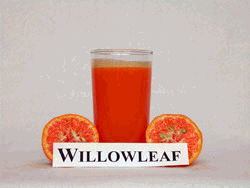 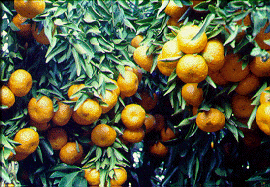   |
| Syn | Citrus deliciosa Tenore Citrus reticulata var. deliciosa Blanco Citrus reticulata var. salicifolia Blanco Citrus nobilis var. deliciosa Loureiro Citrus salicifolia Raf. |
|
| Mediterranean mandarin
(Willowleaf
in the US)
is the common mandarin of the Mediterranean basin, which is known by
many names including Ba Ahmed (Morocco), Blida, Boufarik and Bougie
(Algeria), Bodrum (Turkey), Paterno and Palermo (Italy), Nice and
Provence (France), Valencia (Spain), and Setúbal (Portugal). Synonyms for common or native are commune (French), comuna (Spanish), gallego (Portuguese), koina (Greek), yerli (Turkish), and beladi (various spellings) for Arabic. Other names include Effendi or Yousef Effendi (Egypt and the Near East), Avana or Speciale (Italy), Thorny (Australia), Mexirica or Do Rio (Brazil), and Chino or Amarillo (Mexico). In the United States, it is known as the Mediterranean or Willowleaf mandarin. In comparison with the other mandarins, the most distinctive characteristics of the Mediterranean mandarin include: (1) the small size and narrow-lanceolate form of the leaves and the special nature and aroma of the oil they contain; (2) the mild and pleasantly aromatic flavour of the juice; (3) the distinctive nature and fragrance of the rind oil; and (4) the plump and almost spherical seeds. Another distinctive characteristic not confined to this mandarin is the spreading-drooping habit of growth. The rind oil is used in the preparation of perfumes and toilet waters and for the flavouring of confections and carbonated beverages. Petitgrain oil, which is distilled from the prunings and comes mainly from the leaves, has a strong and characteristic odour. See Citrus oils. Since this highly distinctive mandarin appears not to have been found in the Orient, it seems likely that it originated in the Mediterranean basin and almost certainly in Italy, where it appeared between 1810 and 1818. Cultivars: Avana, Chios, Emperor, Montegrina, Natal and Willowleaf. Chapter based on: Robert Willard Hodgson: 'Horticultural Varieties of Citrus' |
||
| ENG | Mediterranean
mandarin, Italian tangerine Willowleaf mandarin |
|
| FRA | Mandarine Méditerranéenne, Mandarine d’Italie | |
| I TA | Avana | |
| Photos | (1) © CCPP (2) © UCR Citrus Variety Collection (3,4) © C. Jacquemond / INRA (5) © IVIA OTRI |
|
| Back to mandarin types | Back to beginning | |
| King
mandarin
Citrus reticulata |
| LAT | Citrus reticulata Blanco ’Japon’ | 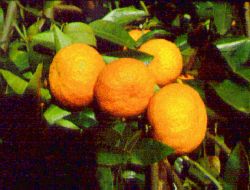 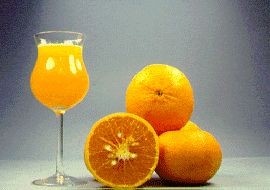 |
| Syn | Citrus nobilis ‘du Japon’ | |
A King-type (Citrus nobilis) variety grown in Japan. The Japanes name Kunenbo refers to this group of mandarins, also found in China, Taipei and Okinawa, as opposed to the satsuma group (Unshȗ mikan) and other mandarins types found in Japan. Characteristics as in King mandarin above. Other King mandarin varieties: 'Guanxi Shagan' 'Huang Yen Man Chieh', 'Huangyan Bendi-guangju', 'Shagan' (China), Som-Chuck' (Thailand). |
||
| ENG | Japanese King mandarin | |
| FRA | Mandarine King du Japon | |
| Photo | © C. Jacquemond / INRA | |
|
|
||
| Back to mandarin types | Back to beginning | |
Mandarin hybrids and small-fruited mandarin relatives page
8.
Tangors
9.
Tangelos
13. Small-fruited mandarin relatives Sour
mandarin
(Citrus sunki) Cleopatra (Citrus resni) Shekwasha (Citrus depressa) Nasnaran (Citrus amblycarpa) Kinokuni (Citrus kinokuni) Citrus lycopersicaeformis Citrus oleocarpa |

|
|
Page up-dated 16 March 2021
Back to top of page


